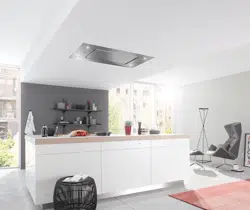Loading ...
Loading ...
Loading ...

Air venting
47
WARNING: Danger of toxic fumes.
Gas cooking appliances release
carbon monoxide that can be
harmful or fatal if inhaled.
To reduce the risk of fire and to
properly exhaust air, the exhaust
gases extracted by the hood should
be vented outside of the building
only.
Do not vent exhaust air into spaces
within walls or ceilings or in attics,
crawl spaces or garages.
To reduce the risk of fire, only use
metal ductwork.
Please read and follow the
“IMPORTANT SAFETY
INSTRUCTIONS” to reduce the risk
of personal injury. Follow all local
building codes when installing the
hood.
Only use smooth pipes or flexible
ducting made from approved non-
flammable materials for exhaust
ducting.
To achieve the most efficient air
thoughput with the lowest noise levels,
please note the following:
- The diameter of the exhaust ducting
should not be less than 6" (150mm).
- If flat ducting is being used, the
cross-section must not be smaller
than the cross-sectional area of the
vent collar.
- The exhaust ducting should be as
short and straight as possible.
- Only use wide radius bends.
- The exhaust ducting must not be
kinked or compressed.
- Ensure that all connections are
strong and airtight.
- If the ducting has flaps, these must
be opened whenever the ventilation
hood is switched on.
Remember that any restriction of the
air thoughput will reduce extraction
performance and increase operating
noise.
If the exhaust is ducted through an
outside wall, a telescopic wall vent or
a roof vent (available as an optional
accessory) is recommended.
If the exhaust air is to be ducted into
a flue, the ducting must be directed in
the flow direction of the flue.
If the flue is used by several
ventilation units, the cross-section of
the flue must be large enough.
Where ducting is horizontal, it must
be laid to slope away at at least
3/8" (1cm) per meter. This is to
ensure that condensate cannot drain
back into the ventilation hood.
If the exhaust ducting is to run
through rooms, ceiling space, etc.,
there may be great variations in
temperature between the different
areas. The problem of condensation
Loading ...
Loading ...
Loading ...
